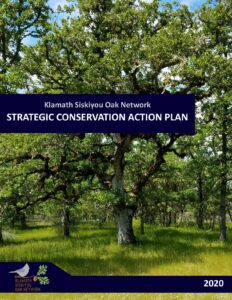KSON History
White oak leaf snow, Rogue Valley. Photo credit: Jaime Stephens
The Klamath Siskiyou Oak Network (KSON) is a regional collaboration between local agencies, tribes, and non-profit organizations that works to conserve oak ecosystems on private and public lands in southern Oregon and northern California. Since 2011, KSON partners have accomplished thousands of acres of strategic ecological restoration to enhance oak habitat, build climate resilience, bolster cultural resources, and reduce wildfire risk to the ecosystem and communities.
Over 6,500 acres have been restored
2010 Established
In 2010, a formal partnership was established to advance regional oak stewardship. On behalf of the partnership, with $500,000 of partner co-investment, including contributions from the US Fish & Wildlife Service, Lomakatsi submitted a successful proposal for $1.8 million to the NRCS Cooperative Conservation Partnership Initiative (CCPI). The resulting Central-Umpqua, Mid-Klamath Oak Habitat Conservation Project accomplished 2,000 acres of restoration across Douglas, Jackson, and Siskiyou counties between 2011 and 2013. The Klamath Siskiyou Oak Network emerged through this partnership, first as an informal working group in 2011 and then with a formal MOU in 2014.
2012 Conservation Award
In 2012, Klamath Siskiyou Oak Network partners were awarded the Department of Interior Partners in Conservation Award, which recognizes “those who make exceptional contributions in achieving conservation goals through collaboration and partnering.” Klamath Siskiyou Oak Network’s efforts were also highlighted as a model of best practices for bird conservation in the 2016 State of North America’s Birds Report.
2015 Investments
In 2015, the partnership brought $1.3 million of co-investment to a successful NRCS Regional Conservation Partnership Program (RCPP) proposal sponsored by Lomakatsi that resulted in $3.2 million to restore approximately 3,200 acres through 2019. This Klamath-Rogue Oak Woodland Health and Habitat Conservation Project spanned private and federal lands from Siskiyou County in California through Klamath and Jackson counties in Oregon. Lomakatsi led prescription development, implementation, and landowner engagement. Klamath Bird Observatory provided expertise in planning and prescription development, using birds as indicators for ecological health, and coordinated implementation and effectiveness monitoring. The Nature Conservancy and Bureau of Land Management provided science expertise, including the Table Rocks Oak Habitat and Vernal Pool Assessment used to guide treatments and monitoring.
Strategic Action Plan
Building off this success the Strategic Action Plan (SAP) was developed in 2020. The plan outlined specific conservation foci for KSON over short (6 years), medium (12 years), and long (30 years) terms. The strategic planning elements served as a road map for achieving continued and accelerated oak woodland conservation in southern Oregon and northern California. The plan focused on four oak woodland targets—Oak Savanna, Oak Chaparral, Oak Woodland, and Oak Conifer—with the goal of conserving all native species associated with deciduous oak ecosystems (e.g., Oregon White Oak and California Black Oak) within the KSON geography.
Using the SAP, KSON identified priority areas for restoration and conservation. This led to the partnership's most recent project, the Upper Rogue Oak Initiative (UROI). This project will restore over 3,000 acres of oak habitat within three watersheds east and northeast of White City and Medford, Oregon. Work will occur throughout the Little Butte Watershed and may extend north as far as the Big Butte Watershed. Restoration will remove conifers that are crowding oaks, use prescribed fire where feasible, reduce noxious weeds, and reestablish a native understory. It was made possible by funding from the Oregon Watershed Enhancement Board, America the Beautiful Challenge, and matching dollars from the Bureau of Land Management and other KSON partners for a total of 13 million dollars.
A crucial part of this project is our continued work at Table Rocks, an important cultural and ecological site in southern Oregon. Table Rock is KSON’s keystone site due to its visibility to the general public, which allows easy access and outreach for oak restoration. Take a hike through history and see if you can spot where restoration has taken place.
